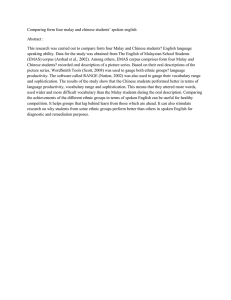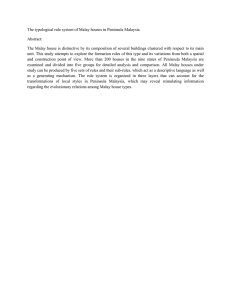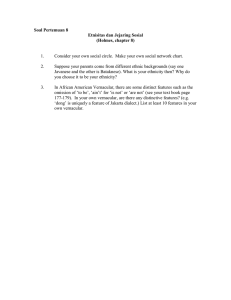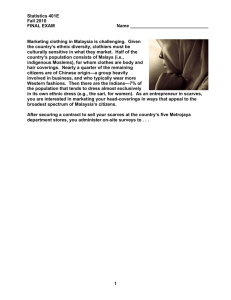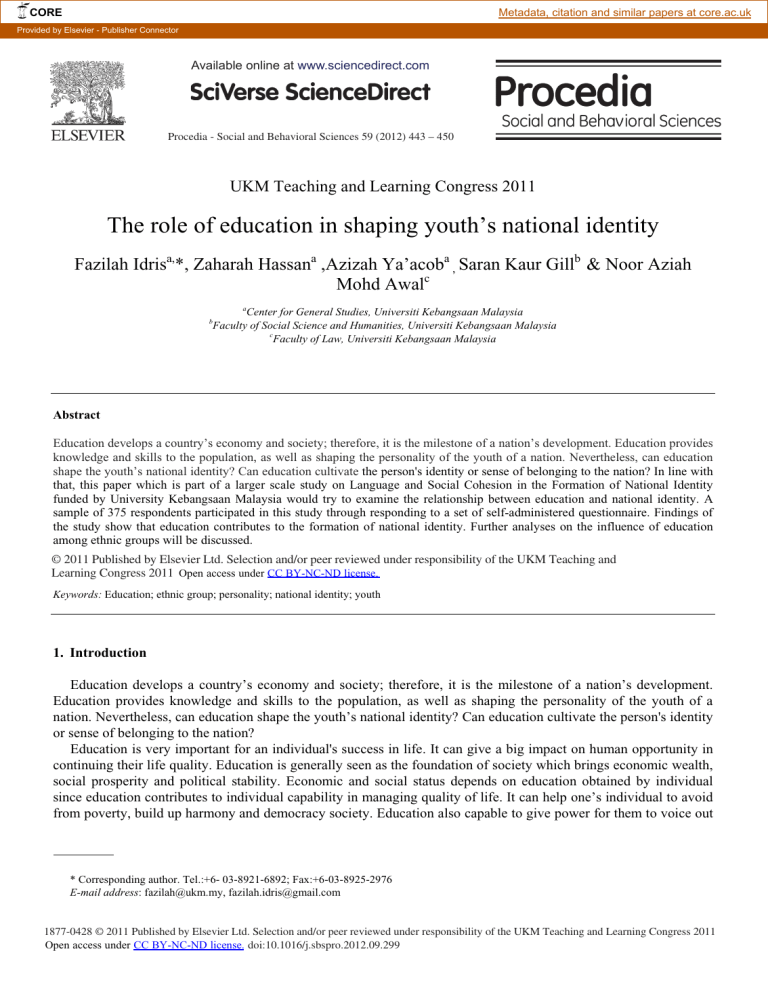
CORE Metadata, citation and similar papers at core.ac.uk Provided by Elsevier - Publisher Connector Available online at www.sciencedirect.com Procedia - Social and Behavioral Sciences 59 (2012) 443 – 450 UKM Teaching and Learning Congress 2011 The role of education in shaping youth’s national identity Fazilah Idrisa,*, Zaharah Hassana ,Azizah Ya’acoba , Saran Kaur Gillb & Noor Aziah Mohd Awalc b a Center for General Studies, Universiti Kebangsaan Malaysia Faculty of Social Science and Humanities, Universiti Kebangsaan Malaysia c Faculty of Law, Universiti Kebangsaan Malaysia Abstract Education develops a country’s economy and society; therefore, it is the milestone of a nation’s development. Education provides knowledge and skills to the population, as well as shaping the personality of the youth of a nation. Nevertheless, can education shape the youth’s national identity? Can education cultivate the person's identity or sense of belonging to the nation? In line with that, this paper which is part of a larger scale study on Language and Social Cohesion in the Formation of National Identity funded by University Kebangsaan Malaysia would try to examine the relationship between education and national identity. A sample of 375 respondents participated in this study through responding to a set of self-administered questionnaire. Findings of the study show that education contributes to the formation of national identity. Further analyses on the influence of education among ethnic groups will be discussed. © 2011 2011Published Publishedbyby Elsevier Selection and/or reviewed responsibility of theTeaching UKM Teaching and Learning © Elsevier Ltd.Ltd. Selection and/or peer peer reviewed under under responsibility of the UKM and CongressCongress 2011. 2011 Open access under CC BY-NC-ND license. Learning Keywords: Education; ethnic group; personality; national identity; youth 1. Introduction Education develops a country’s economy and society; therefore, it is the milestone of a nation’s development. Education provides knowledge and skills to the population, as well as shaping the personality of the youth of a nation. Nevertheless, can education shape the youth’s national identity? Can education cultivate the person's identity or sense of belonging to the nation? Education is very important for an individual's success in life. It can give a big impact on human opportunity in continuing their life quality. Education is generally seen as the foundation of society which brings economic wealth, social prosperity and political stability. Economic and social status depends on education obtained by individual since education contributes to individual capability in managing quality of life. It can help one’s individual to avoid from poverty, build up harmony and democracy society. Education also capable to give power for them to voice out * Corresponding author. Tel.:+6- 03-8921-6892; Fax:+6-03-8925-2976 E-mail address: fazilah@ukm.my, fazilah.idris@gmail.com 1877-0428 © 2011 Published by Elsevier Ltd. Selection and/or peer reviewed under responsibility of the UKM Teaching and Learning Congress 2011 Open access under CC BY-NC-ND license. doi:10.1016/j.sbspro.2012.09.299 444 Fazilah Idris et al. / Procedia - Social and Behavioral Sciences 59 (2012) 443 – 450 their views, expose to them their real potential, lead them to become a better person and widen their views in certain area. Education is the key to move in the world, seek better jobs and ultimately succeed in life. Education is the best investment for the people because well educated people have more opportunities to get a job which gives them satisfaction. Educated individuals enjoy respect among their colleagues and they can effectively contribute to the development of their country and society by inventing new devices and discoveries. Main purpose of education is to educate individuals within society, to prepare and qualify them for work in economy as well as to integrate people into society and teach them values and morals of society. Role of education is means of socializing individuals and to keep society smoothing and remain stable. Education in society prepares youngsters for adulthood so that they may form the next generation of leaders. One of the education essential tasks is to enable people to understand themselves. Students must be equipped with knowledge and skills which are needed to participate effectively as member of society and contribute towards the development of shared values and common identity. 2. Literature review 2.1 What is education? Education means a change in man's conduct of life. It means the upgrading of a man's ability to choose the best alternative available in any circumstance he faces. It means the development of the person to prepare him to adopt the best approach to a problem at any given time. Education defined as 'adjustment ability to a changing situation and environment'. Education is more than an economic investment: it is an essential input upon which life, development and the survival of man depend. We all know that it is the responsibility of everyone in a country to educate; whether we are parents, adults, children, or teachers, in the public or private sector, education is the responsibility of everyone. But however we see the needs and problems, most of us would agree that the role of education is to help provide the opportunity for all people to develop as fully as possible. Education should be a means to empower children and adults alike to become active participants in the transformation of their societies. Learning should also focus on the values, attitudes and behaviors which enable individuals to learn to live together in a world characterized by diversity and pluralism. Education therefore has a crucial long-term role in developing a knowledge and understanding of human rights, the values base they represent and the skills required to strengthen a democratic culture. 2.2 Roles of Education The role of education is inevitable in producing new generation that enable in solving the real problems in our society. Today's ever growing numbers of people mostly are not satisfied with their basic education and try to get secondary or tertiary education in order to meet the demands of contemporary society. They sacrifices their time and money and sometimes even their health to raise educational level because they realize that education is their passport to the future and for tomorrow. The school also can play a role in supporting youths’ development toward a positive sense of ethnic identity. For instance, they can organize several programmes that can build up their sense of interaction among the ethnicity. At the same time, they can improve their understanding on other ethnics. By implementing these programmes, they will know the strengths and uniqueness of ethnic identity in Malaysia. When the students have full understanding in ethnic identity, they will become more tolerate and respect on others ethic group. Community service is another area of the curriculum that can help in cultivating and instilling the sense of national identity. It can be an important part of civic education, provided it is properly conceived as being more than just doing good deeds. It can contribute to the effort in instilling the value of solidarity among races especially the teenagers. It includes the activity that stressed about tolerance and harmony value regardless religion and race aspect. For example, nationality module can help them to learn and know in depth about their country and others custom and culture. At the same time, they know the uniqueness of others culture. Hence, the purpose of the community programme is to inculcate a sense of citizenship, whereby students learn the importance of contributing to their own community, the society at large and to the nation. By doing community service, students will also develop a sense of civic duty and commitment to the nation. Apart from that, the establishment of Sekolah Wawasan Fazilah Idris et al. / Procedia - Social and Behavioral Sciences 59 (2012) 443 – 450 445 also can help the students to be able mix up with students in other religion. It can give them an opportunity to interact in others activities. It can help them to be more flexible in judging others religion and widen their view on certain aspect in others races. 2.3 National identity via Education In Malaysia, religion is a vital institution in society’s life. Religion is not only considered as spiritual guidance, but it also can be regarded as ethnic identity for one’s race, like Malay, Indian, Chinese and so forth. Ethnic identity can be regarded as individual’s sense of self in terms of membership in a particular ethnic group. Ethnic identity is generally seen as embracing various aspects including self-identification, feelings of belongingness and commitment to a group, a sense of shared values and attitudes toward one’s own ethnic group. Harmonious collaboration, the values of Islam and other religious values that have much in common are accepted and practiced which in turn forms the basis for building a united society. Differences from the aspects of religion, language and culture are quite challenging for the government to manage and the difference is more difficult as each continues to prioritize their own people in choosing friends, offering jobs and in daily interaction that could lead to ethnic polarization. How can this be avoided?. Education can be regarded as systematic efforts that build up by the society in order to deliver the knowledge, value, attitude and skill among their group members towards an effort to enhance individual’s potential and changes that occurred in themselves. This definition is consistent with Education Philosophy whereby "Education in Malaysia is an on-going effort towards further developing the potential of individuals in a holistic and integrated manner, so as to produce individuals who are intellectually, spiritually, emotionally and physically balanced and harmonic, based on a firm belief in and devotion to God. Such an effort is designed to produce Malaysian citizens who are knowledgeable and competent, who possess high moral standards and who are responsible and capable of achieving high level of personal well-being as well as being able to contribute to the harmony and betterment of the family, the society and the nation at large". National identity is formed by a society that exists in it. Thus, all the science of education both in terms of skills, academic and personal is very important to the country in forming the personality of youth today. Education received by students is what shapes the identity of the country where education have a substantial impact on life opportunities to acquire good quality and identity. Therefore, quality education is a dynamic concept of change and evolves over time and changes in the context of social, economic and environmental. According to Ross and Wu (1996), education level of individuals incapable of managing the quality of life for economic and social development depends on the education received. Through education, individuals can build self-esteem among them the confidence to face the world and society and to understand the heart's desire. Wehmeyer (1996) states that selfassertiveness is the foundation of one's life. With firmness, individuals are capable of making choices and decisions on actions and break free from outside influence or interference that is not beneficial. Assertiveness and confidence is a knowledge derived from education. Without education, ones self-esteem is not as strong as a person who acquires knowledge in education. Obviously education has a very important role in transmitting and fostering values that determine, in turn, behaviours, attitudes, reactions specific of responsible citizens. According to Deni Hardianto (2005), failure of education in shaping the national identity is due to the components in the education system. All members of society including teacher, educational facilities and government’s commitment need to get involved in improving education. For instance teachers also must have a strong identity and at the same time strong commitment in cultivating the sense of identity to the students. The government needs to play an important role in the development of national education. It includes provide adequate education, take care of teacher’s welfare and avoid making education as a political medium. 3. Methodology The respondents for the study were 376 first year and final year undergraduates who enrolled at University Kebangsaan Malaysia (UKM). Out of the 376 respondents, there were 117 males and 239 females. In terms of ethnicity, 248 (64.9%) of the respondents were Malays, 98 ( 25.7 %) were Chinese, 23 ( 6 %) were Indians, 7 (1.8%) were bumiputras from Sabah and Sarawak and 6 (1.6%) of other ethnicities. In terms of faculty, 208 students from 446 Fazilah Idris et al. / Procedia - Social and Behavioral Sciences 59 (2012) 443 – 450 Science faculty (medical, dentistry, allied sciences, Science and technology, engineering) were participated in this study. Meanwhile, students from Arts faculty (education, science social and humanities, economics, information technology) consists of 148 students. All of the 376 respondents who participated in this study have to respond on a set of self-administered questionnaire. The questionnaire used for this study was developed with the goal of understanding the impact of the national language towards the formation of a sense of national identity and unity. The questionnaire is designed using a 5 point Likert scale and is divided into six sections; Section (A) of the questionnaire comprises questions on demographic information. Section (B) investigates national identity while Section (C) investigates the understanding of the 1Malaysia concept. In addition, Section (D) investigates how language and culture reflect the national identity among university students and Section (E) investigates the language choice and functions outside classroom. Finally, Section (F) measures the contribution of language and culture in enhancing or dividing the community. This paper will only present selected sections of the questionnaire which are relevant to the focus of the paper. Data was analyzed using SPSS version 15.0 and the reliability factor was done by using the Cronbach reliability analysis approach. It was found that the instrument developed has a high reliability. 4. Findings and Discussion Table 1. Classification of Levels Classification Level Range of Mean Score Low 1 - 2.33 Moderate 2.34-3.67 High 3.68-5.00 Using the classified levels, the composition of the respondents with respect to their identity were identified using frequencies. The results are shown tables below. Table 2. Percentage Levels of identity by gender Gender Male Female Low Moderate High n 1 % .8 n 6 % 4.8 n 117 % 94.4 0 .0 12 4.8 239 95.2 Based on the above table, more than three-quarters of male students (94.4%) and females (95.2%) had high level of identity. Based on the analysis, difference in gender does not affect the level of identity be it high or low because self-esteem refers to how one is thinking about themselves (William Stewart, 2000). In this regard, education received helped students to form the individual's identity. Table 3. Level of Identity across stream of studies Discipline Science Arts Low Moderate High n 1 % .5 N 4 % 1.9 n 208 % 97.7 0 .0 14 8.6 148 91.4 Based on Table 2, analysis results showed that more than 90 % of the science stream students (208 students) and arts stream students (148) had high levels of identity. Through this analysis also reveals that only one student (5%) in the science stream with low self-esteem level. According to the Drum (1977), the student development process 447 Fazilah Idris et al. / Procedia - Social and Behavioral Sciences 59 (2012) 443 – 450 involving student behavior change towards a more complex due to increasing maturity in his life. Therefore, we can see that the students who are active, whether in association of academic, social, religious or sports while studying at the school will usually be able to show him very well in society as well as further in his education at the university. The identity of which has been formed from an early age will bring a person in to a better direction in her or his life. Table 4. Level of Identity across year of studies Year Low Moderate High n % N % n % one 1 .8 6 4.7 120 94.5 three 0 .0 12 4.8 236 95.2 Based on table 4, 120 students from year 1 (94.5) and 236 students from year 3 (95.2) had high level of identity. High level of identity indicates that the students built their identity through the education received at school. In line with that, university as an institution in the process of expanding and cultivating knowledge must also be responsible to meet the aspirations and expectations of the community and country to produce students who are skilled, able to think rationally, critically, creatively, innovatively, disciplined and honorable (Isaac, 1998; Khairul Annuar, 1998; Norfadzillah Black, 1997; Eh.Chot Cha Chan, 1987). Table 5. Identity by Primary Education Primary Education Low Moderate High n % n % n % Religious School 0 .0 0 .0 11 100.0 National School 0 .0 3 1.2 252 98.8 Vernacular School 1 .9 15 13.8 93 85.3 Based on the above analysis results, it was found that more than three-quarter of students from the three types of schools: religious school (100%), national school (98.8%) and vernacular school (85.3%) had high levels of identity. In line with the result, Charles and Albert (1999) mentioned that peers provide social and emotional support network that helped most teenagers to become more independent, and develop their own personal identity. Table 6. Identity by Secondary Education Types of School Low Moderate High n % n % n % Religious school 0 .0 1 2.0 50 98.0 National school 1 .4 10 3.5 272 96.1 Vernacular school 0 .0 7 17.1 34 82.9 Based on the above analysis results, it was also found that more than three-quarter of students from the three types of school: religious school (98%), national school (96.1%) and vernacular school (82.9%) had high levels of identity. This high level of student identity is in line with Paul B. Hotton (1964) who explained that the existing 448 Fazilah Idris et al. / Procedia - Social and Behavioral Sciences 59 (2012) 443 – 450 system of interaction between students in the school with other students or the interaction between students in the same school create a healthy personality development. In addition, through the activity or activities in schools that have been integrated with social interaction, communication and cooperation among members could enhance the formation of identity. Table 7. Identity by Majority of Residents at Residential Area majority Low Moderate High Malay n 0 % .0 n 4 % 1.8 n 218 % 98.2 Chinese 1 1.2 12 14.1 72 84.7 Indian 0 .0 16.7 5 83.3 0 .0 1 0 .0 3 100.0 0 .0 0 .0 31 100.0 0 .0 0 .0 10 100.0 0 .0 1 16.7 5 83.3 0 .0 0 .0 9 100.0 0 .0 0 .0 3 100.0 others Malay/Chinese Malay/Indian Chinese/Indians Malay/ Chinese/Indians Malay and others Similar results were also obtained. More than three-quarter of students from different backgrounds living environment had high levels of identity. Accordingly, Ma'arof Redzuan (2005) explains that the attitude is one important component of personality, and it refers to the combination of beliefs, feelings and behavior tendencies directed toward the object. Thus, where an individual tends to behave positively to ethnic relations, he will tend to behave positively in inter-ethnic interaction in their daily lives. Table 8. Relationship between Gender and Identity (Independent T-Test) H1: There is a significant relationship between gender and level of identity Gender Male Female df=373 min sd 4.37 .463 4.44 .412 t-value p-value -1.448 .148 The analysis of independent t-test result, showed no significant relationship between gender and identity [t =1,448, df = 373, p> 0.05]. Therefore, there is no conclusive evidence to reject the null hypothesis. This finding showed that gender identity does not affect the level of the students in this population (n = 375). Table 9. Relationship between Primary Education and Identity H1: There is a significant relationship between primary education and identity Primary education Min sp Religious school 4.51 .378 National School 4.54 .322 F-value p-value 48.488 .000 449 Fazilah Idris et al. / Procedia - Social and Behavioral Sciences 59 (2012) 443 – 450 Vernacular School 4.11 .502 D.F.=2,372 Results of analysis one-way ANOVA test showed that there was a significant relationship between primary schools and the level of identity [df (2.372) = 48,488, p <0.05]. Bonferroni test analysis results showed that the mean value between the religious school and vernacular school [mean difference =- 402, p <0.05], the national and vernacular schools [mean difference = 0431, p <0.05] was significant. The mean value of the vernacular school [mean = 4.11, sp = 0502] is much lower than other types of schools. Therefore, we can conclude that students with vernacular background have a lower level of identity if compared to religious and national school. Table 10. Relationship between Majority Residential Area Residents and Identity H1: There is a significant relationship between secondary schools and identity Types of Secondary School Mean Std. Deviation Religious School 4.55 .331 National School 4.43 .410 Secular School 4.14 .549 F-value p-value 12.083 .000 D.F=2,372 ANOVA test results showed that there was a significant relationship between secondary types of school and level of identity [df (2.372) = 12,083, the value of p <0.05]. Results showed that the mean pair comparisons between the religious school and vernacular school [mean difference = 0417, P <0.05], the national school and vernacular school [mean difference = 0294, p <0.05] was significant. Mean value of students who are studying in vernacular schools [mean = 4.14, sp = 0549] is lower than the mean value of students who are studying in religious school and national schools. This finding indicates the level of identity for a vernacular schools student is lower than students with a background of religious schools and national schools. Table 11. Relationship between Majority Residence at Residential Area and Identity H1: There was a significant relationship between majority residence at residential areas and identity Majority N Min sp Malay 222 4.52 .333 Chinese 85 4.09 .529 Indian 6 4.44 .659 others 3 4.88 .063 Malay/Chinese 31 4.52 .270 Malay/Indians 10 4.43 .283 Chinese/Indians 6 4.15 .650 Malay/Chinese/Indians 9 4.51 .401 F-value p-value 10.258 .000 450 Fazilah Idris et al. / Procedia - Social and Behavioral Sciences 59 (2012) 443 – 450 Malay and others D.F=8,366 3 4.60 .237 The result of one-way ANOVA analysis showed significant relationship between the majority residence at residential areas and identity [df (8.366)=10,258, p <0.05]. This result indicated that the majority of the population in residential areas influences the level of student identity. Bonferoni tests showed that the mean value between Malay and Chinese [mean difference = 0.423, p <0.05], Chinese and others [mean difference =- 0782, p <0.05] and Chinese, Indians and Malays [mean difference =- 0428, p <0.05] was significant. Therefore, it can be concluded the majority of people in residential areas influence the level of student identity significantly. 5. Conclusion As a conclusion, education plays a significant role in achieving a good quality of life. It is because education is importance guidance in human’s life. It can be regarded as important medium in changing the paradigm shift in one’s individual. Generally, education is always associated with the process of delivering skill, disseminating knowledge and internalizing value. Practically, individual who equipped with knowledge can be able to internalize and apply the knowledge in everyday’s life. In children’s context, education can be seen as continuing process of their development, so that they can practice and apply their knowledge as preparation in the future. Thus, education is major aspect of development of any modern society since if there is a deficit of educated people then society will stops its further progress. Acknowledgement We would like to thank Universiti Kebangsaan Malaysia for providing the research grant UKM-GPP-PPKK-6-2009. References Charles, G. & Albert, A. (1999). Psychology an Intoduction. Ed. Ke-10. Pentice Hall: New Jersey. Imazeki, J. & Reschorsky, A. (2003). Financing adequate sducation inRural Setting. Journal of Education Finance, 29 Fall, 137-156. Ma’arof Redzuan. (2001). Psikologi Sosial. Penerbitan Putera Malaysia. Serdang , Selangor. Nik Safiah Karim. (2006). Kamus Dewan Bahasa dan Pustaka. Kuala Lumpur. Dewan Bahasa dan Pustaka. Paul, B. H. & Chester, L. H. (1994). Sociology. USA: McGraw Hill Book Company. Pelan Induk Pembangunan Pendidikan. (2006-2010). Membina Negara Bangsa. Preston, S.H. & Elo, I.T. (1996). Survival after age 80: letter to the editor. New England Journal of Medicine,334(8),53 Ross, C. & Wu, C.L. (1996). Education, age,and the Cumulative advantage in health. Journal of Health and Social Behaviour, 37:104-120. William Stewart. (2000). Building Self-Esteem. Golden Books Centre Sdn. Bhd. Kuala Lumpur Zaid Ahmad. (2006). Hubungan Etnik Di Malaysia. Shah Alam : Oxford Fajar Sdn. Bhd.
